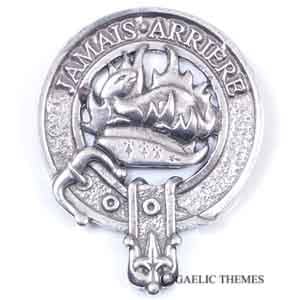Douglas
Select
- Clan Motto: Jamais arriere (Never Behind)
- Notes:
Crest: A salamander Vert encircled with flames of fire Proper
Despite being one of Scotland’s most powerful families, the origins of the Douglas clan are obscure. The name is territorial -- probably referring to lands by Douglas Water received by a Flemish knight from the Abbey at Kelso. The first certain recording is of one William de Dufglas who witnessed a charter by the Bishop of Glasgow to the monks at Kelso in 1199. The next historical reference is to Sir William de Douglas, whose sons fought the Norse at Largs in 1263.
A William Douglas ‘The Hardy’ was governor of Berwick when the town was besieged by the English. He would go on to fight with William Wallace but was captured and died in England in 1302. His son, ‘The Good Sir James’ founded the Black Douglases. Another great fighter, he was slain in Spain while escorting the heart of his king and friend, Robert the Bruce, to the Holy Land.
The second earl married a Stewart princess which brought greater wealth and prestige. The third earl, Archibald the Grim, consolidated the family holdings. He also defended Edinburgh castle against Henry IV of England in 1400.
Archibald, the fourth earl, married a sister of James I. In 1437 upon the death of the king, Archibald served on the council of regents and later as Lieutenant General of the kingdom. Both he and his son died fighting the English in France.
By the early fifteenth century, the Douglases had become powerful enough that they were seen as a threat to national stability. Thus in 1440, the young sixth Earl and his brother were invited by a rival to dine at Edinburgh Castle with King James II, who was only ten. After a mock trial, the Douglases were beheaded in front of the boy king. He was reportedly horrified. Nevertheless, twelve years later James himself struck the first blow in the murder of the eighth earl Douglas.
The Red Douglases were founded by George, first earl of Angus, who also married a Stewart princess. The fifth Earl of Angus was Archibald ‘Bell the Cat’ (a nickname based on his courage in a conspiracy to eliminate certain unliked nobles at court) who eventually rose to be Lord Chancellor of Scotland. Archibald’s grandson, the sixth earl, married the widow Margaret Tudor and thus made himself guardian of her son, the young James V.
James, Earl of Morton and younger brother of the seventh earl, was one of the murderers of Mary Queen of Scot’s secretary, David Rizzio. James was also deeply implicated in the assassination of Mary’s second husband Lord Darnley. James served as Regent during the infancy of James IV, but fell from power and was executed in 1581.
William, the eleventh earl was a staunch Catholic. During the Civil War, he supported Charles I. Created first Marquess of Douglas in 1633, he kept Douglas Castle in luxurious style. William fought with Montrose at Kilsyth and at Philiphaugh in 1645 where he escaped the onslaught of the Covenanter cavalry.
The titles of Marquess of Douglas and Earl of Angus devolved to the Dukes of Hamilton after the second Marquess Douglas married into that family in 1660.
Other family lines include the earls of Morton, and the Marquesses of Queensberry (famous for their rules for boxing). The Douglas-Hamiltons are the heirs to the house of Douglas, but are barred from matriculating as Chiefs because of their hyphenated surname. The family seat is at Lennoxville near Haddington.
